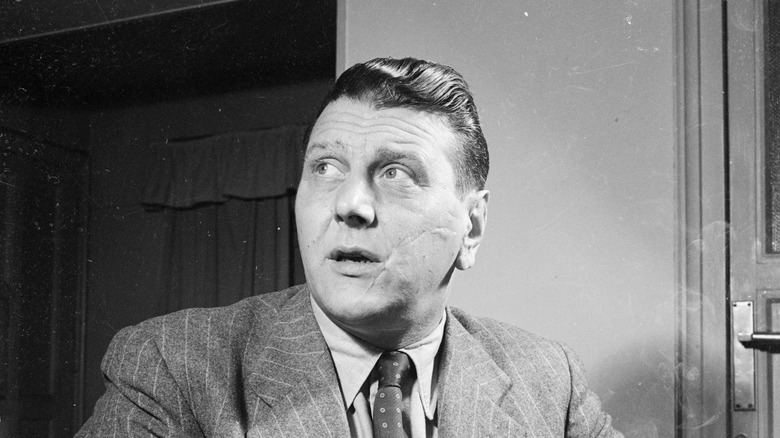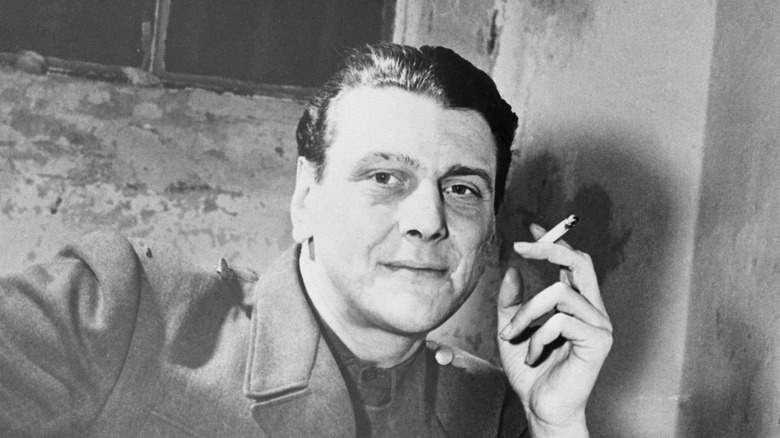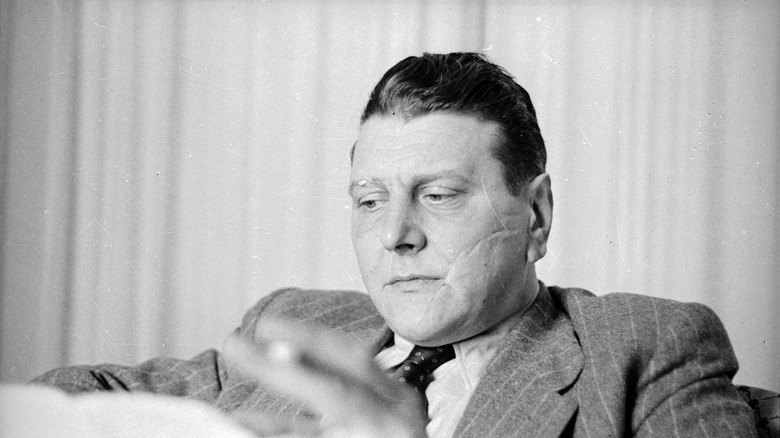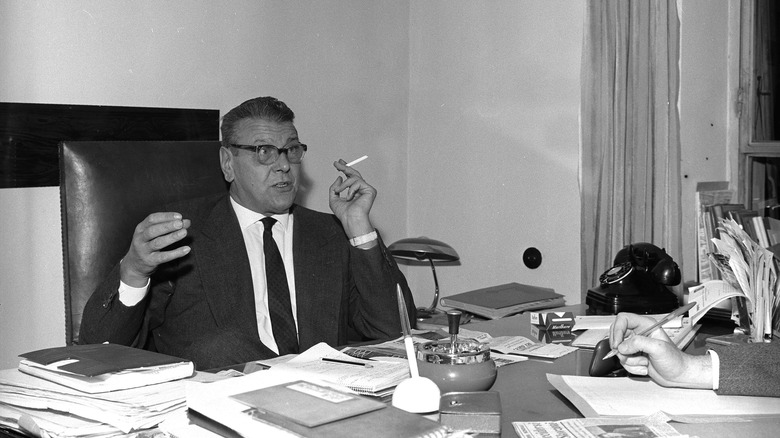The Strange True Story Of Hitler's Best Assassin
The story of Adolf Hilter is horrific, tragic, and many other words in the English lexicon. The man who led one of the worst genocide's in human history began as a struggling artist before spiraled down a dark path fueled by hatred of others, shame of his and his country's failures, and escalating drug use. He was surrounded by other morally reprehensible people on the way to his inevitable demise, and while Joseph Goebbels is one of the most well-known, lesser discussed is one of Hitler's best assassins: SS Lieutenant Colonel Otto Skorzeny.
Skorzeny's rise is one that fits right into the stories of Hitler and those around him who committed unspeakable atrocities. He joined the Nazi Party in the early 1930s, around the time Hitler took power as German chancellor and began his ruthless campaign against Jewish people. In a strange twist of fate that is still not quite understood, he later wound up working as a hitman for Israel's intelligence agency, Mossad, and assassinating Nazi rocket expert Heinz Krug. Here's his story.
Early life amid an economic depression
Otto Skorzeny had fairly humble beginnings. Unlike Adolf Hitler, who was born into a family of poor farmers in a small Austrian town, Skorzeny was born to middle-class parents in Vienna. Still, he lived through the economic depression that followed Austria's defeat in World War I, which saw the region struggle with high rates of unemployment. The country was effectively helpless to the external forces that drove this downturn, devastating its economy and infrastructure. It was during this hardship that Skorzeny's father instilled in him the values needed to survive a "Spartan life," as an American Intelligence Journal article puts it.
This mindset seemed to drive Skorzen's path as a child. He took up fencing and fought others with live steel — dangerous contests called Mensurs (student duels) that left him with his signature scar across his face. Even today, these ritual duels are common at German universities, which often have secret meetings and rules governing the contests. He graduated from Vienna University with a degree in engineering on December 11, 1931.
Rising through the Nazi Party
It was after graduation that Otto Skorzeny began to walk the path that put him in the most violent pages of history. Though his father taught him the Spartan mindset as a child, it appears that his son's path is not one he agreed with — his parents were "staunch opponents" of the Nazi Party, according to the American Intelligence Journal. Nevertheless, after graduating, Skorzeny joined the Austrian Nazi Party amid frustration with Austria's economic depression.
In 1934, he joined the Sturmabteilung (SA), or Storm Division, the paramilitary organization of the Nazi Party. It was a crucial part of Adolf Hitler's rise rise to power, providing personal security to his supporters and employing violent methods of intimidation against their political opponents. Skorzeny was too tall and too old to join the Luftwaffe when World War II broke out, so in 1939 he joined the Waffen-SS and joined the führer's personal bodyguard unit: Leibstandarte SS Adolf Hitler. The regiment ruthlessly slaughtered civilians and prisoners of war, and it wasn't long before Skorzeny began to make a name for himself thanks to his "resourcefulness, daring and deception," as WGBH says. From here, he became a colonel in the Waffen-SS Division Das Reich, and eventually he was tasked with equipping the 1. SS-Division with armor in 1942. Then, the Reichssicherheitshauptamt, or Main Office of State Security (RSHA), assigned him to a covert commando role, which led to one of his most notorious escapades.
A daring rescue
Otto Skorzeny's skills and penchant for adventurism helped him rise fast in the Nazi Party, and as the head of Germany's special units, the SS Jagdverbände, he earned perhaps his most notable achievement, if you could call it that. It all happened under Operation Eiche, a Bond-esque mission that involved rescuing Benito Mussolini at Campo Imperatore in the Abruzzi mountains. According to the U.S. Army Special Operations Forces Historical Office, Adolf Hitler himself appointed Skorzeny to rescue the Italian Fascist Party leader from a hotel tucked away on the Gran Sasso massif over 5,000 feet in the air. On September 12, 1943, Skorzeny's team of 12 gliders reportedly flew over a cliff and dropped 1,000 feet, landing on the mountainside behind storming the hotel. Just four minutes later, Skorzeny bluffed his way to victory: The 200 Italian guards, who History says were "bewildered," surrendered Mussolini.
As is common in history, the exact details of Operation Eiche are debated. According to the Swiss National Museum, the framing of Skorzeny as the courageous mastermind behind the operation might have been a classic case of Nazi propaganda. He was a "peripheral figure" in the operation, the institute says, and the real work was done by German paratroopers. The assault was allegedly headed not by Skorzeny but a German officer: Major Harald Mors.
A surprising turn as an Israeli spy
The strangest twist in Otto Skorzeny's story is when he went on to work for Mossad, Israel's foreign intelligence agency. Formed in 1949 over a year after the country was established, it is often considered the equivalent to the United States' CIA and has been linked to dark figures like accused sex trafficker Jeffrey Epstein. Skorzeny joined the service after World War II and acted as a hitman. His targets? Former Nazi rocket scientists.
After World War II, Mossad set its Nazi-hunting Operation Damocles into motion and set its sights on rocket scientists working in Egypt. Skorzeny wound up assassinating Nazi rocket expert Heinz Krug on September 11, 1962. Krug was reportedly working on weapons intended to wipe out Israel. Egypt's President Gamal Abdel Nasser notably threatened to destroy the country in 1967, and Israeli's believed that Nasser was a figure akin to Adolf Hitler. At the time, Jewish newspapers like the Wisconsin Jewish Chronicle characterised his leadership as "genocide plans against the Jewish people in Israel."
Death and legacy
The death of Otto Skorzeny is one that seems almost too banal for someone whose life involved such a strange mix of chaos and atrocities. He died of bronchial cancer on July 5, 1975, at his home in Madrid, Spain — a far cry from the man who was once called "the most dangerous man in Europe," as The New York Times reported. Hundreds of former Nazis attended his two funerals in Madrid and Vienna, and his remains were cremated and taken to Vienna by his widow. He was interred in the family plot.
Otto Skorzeny was very wealthy at the time of his death, and he never revealed why he chose to work for Mossad. In a piece for Forward, journalists Dan Raviv and Yossi Melman suggested some reasons for this. One might have been the allure of the work, as he "had a very strong streak of adventurism." "Skorzeny was the kind of man who would feel most youthful and alive through killing and fear," they wrote. "Regret and atonement" might have also been factors, though they noted that Mossad's psychological analysts doubted this was the case. Whatever his reasons, he was among many Nazis who never truly faced the comeuppance that others did for their role in one of the most horrifying campaigns of violence that the world has ever known.





